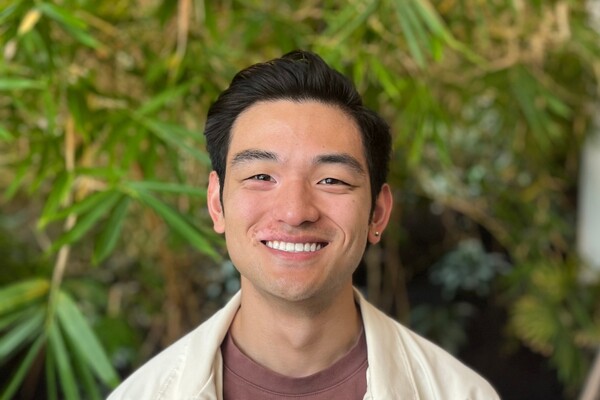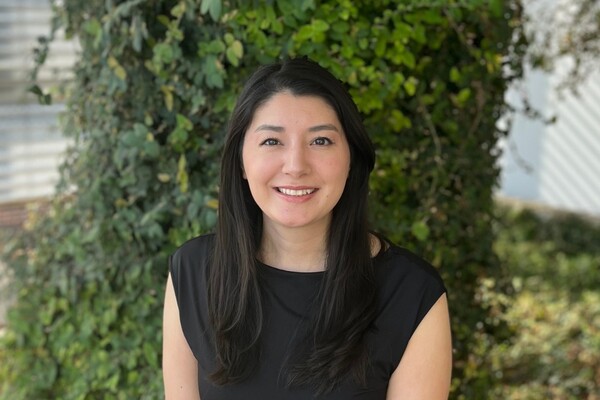Main Second Level Navigation
2024 Dorrington Award recognizes graduate students innovating myopathy research, mapping the liver and advancing personalized medicine

The Donnelly Centre for Cellular and Biomolecular Research recognizes three outstanding graduate students each year with the Jennifer Dorrington Graduate Research Award. The award supports the students’ continued progress in achieving their research goals while contributing to the Centre’s history of excellence in advancing discovery, medicine and health.
The recipients of the 2024 Jennifer Dorrington Graduate Research Award are Heta Lad, Delaram Pouyabahar and Justin Sing.
“On behalf of everyone on the Jennifer Dorrington Graduate Research Award committee, I would like to offer my congratulations to this year’s winners,” said Gary Bader, professor of molecular genetics and chair of the 2024 Jennifer Dorrington Graduate Research Award selection committee. “Heta Lad, Delaram Pouyabahar and Justin Sing are all exemplary researchers who embody the innovative and collaborative spirit of the Donnelly Centre.”
Bioengineering muscle tissue to study critical illness myopathy
Heta Lad is a PhD candidate conducting research under the supervision of Penney Gilbert, associate professor of biomedical engineering.
Lad has spent the last decade pursuing educational and research experience at the University of Toronto, with the entirety of her graduate career taking place at the Donnelly Centre.
An interest in understanding the underlying mechanisms of human disease was sparked in Lad as an undergraduate student. This interest was refined to focus on disease impacting muscle and bone through research on muscle loss caused by cancer mutations and bone loss caused by complications during surgery.
Lad was naturally drawn to Gilbert as a mentor in tissue bioengineering. Working with Gilbert promised to offer research experience that would align with Lad’s interdisciplinary interests by merging lab research and clinical work.
The Gilbert lab works with innovative muscle models to study the effects of disease and test methods of treatment. The model Lad works with is known as an organ-on-a-chip – an emerging technology allowing for experimentation in real time on miniature models that mimic the structure and function of human tissue.
Lad joined the Gilbert lab as a Master’s student, with the goal of optimizing the organ-on-a-chip platform for studying critical illness myopathy, which is clinically-detected muscle weakness in critically ill patients.
Lad introduced human blood serum to the organ-on-a-chip platform to observe its effects on muscle tissue afflicted with critical illness myopathy. She optimized the platform to determine the precise dosage of serum, treatment length and treatment timing to elicit the desired effects on muscle tissue.
“There were so many emerging projects in the lab,” said Lad. “It made me excited about what could be learned from them and applied to my own research. That’s why I wanted to stay in the Gilbert lab as a PhD student. I really wanted my Master’s project to evolve, especially after seeing how timely and relevant the research was for COVID-19 patients.”
Now working towards earning a PhD degree in the Gilbert lab, Lad is studying significant muscle loss in intensive care unit (ICU) patients. There is currently no treatment for this type of critical illness myopathy, nor is early detection possible, as the cause is unknown.
Using the organ-on-a-chip system she optimized as a Master’s student, Lad was able to reproduce hallmarks of critical illness myopathy, such as muscle atrophy, with blood serum from critically ill patients.
The next step of the study will be to determine the components of the blood serum that are driving loss of muscle strength. Lad will combine the results with clinical data, such as patient age and the length of their ICU stay, to inform treatment development.
Lad expects to complete her PhD research and graduate later this year. She is planning to continue her research pursuits as a postdoctoral fellow, with a focus on disease modelling and investigating targeted therapeutics.
Mapping the liver at single-cell resolution
Delaram Pouyabahar is a PhD candidate conducting research under the supervision of Gary Bader, professor of molecular genetics.
Pouyabahar completed her undergraduate degree in cellular and molecular biology at the University of Tehran. It was during her second year as an undergraduate student that she became interested in computational biology and started to build a foundation in computational skills through a bioinformatics project on network analysis.
“I knew I wanted to be a scientist since I was 14 years old,” said Pouyabahar. “I didn’t have to do a project in my second year as an undergraduate student, but I was already interested in doing research in bioinformatics. I also wanted to get wet lab experience, so I did internship at a structural biology lab in Germany the following year. I decided I prefer computational work.”
After graduating, Pouyabahar took a year-long break from academia to work in both a lab and a start-up in Iran while looking into PhD programs. During her gap year, she was introduced to machine learning.
Pouyabahar would later enroll in the computational biology PhD program at U of T. She chose to join the Bader lab for its focus on method development, and credits Bader for being a supportive, trusting and well-connected mentor who has opened doors for many collaborations.
For her PhD dissertation, Pouyabahar helped to create an atlas of cells in the liver. She realized there were gaps in the available data, resulting in challenges to studying the liver. These challenges drove her to develop new methods of data analysis.
The second target of Pouyabahar’s research was removing ‘noise’ from the liver cell data caused by biological contamination of cells. The noise clouds the data that is relevant and useful to researchers, preventing precise analysis and reliable results.
Pouyabahar developed a computational method to separate noise from real data on two rat strains – one of which tolerated liver transplantation while the other rejected it. She used statistics and machine learning to separate the liver data into smaller and simpler components, from which it would be easier to remove noise and understand what was happening with the rat strain that rejected liver transplantation.
From this new computational method, Pouyabahar learned that the macrophages, which are a type of white blood cell, found in the transplant-rejecting rat strain produce more inflammation than the macrophages in the other strain.
The final project Pouyabahar will conduct as part of her PhD research is to develop a scalable statistical method for large cell atlases to compare population of cells across different conditions, such as in healthy and diseased states.
Through her PhD research, Pouyabahar hopes to contribute to our understanding of sources of variation in single-cell transcriptomic maps to guide therapeutic development. She expects to graduate this year, with plans to continue in academia as a postdoctoral fellow.
Improving mass spectrometry data analysis for personalized medicine
Justin Sing is a PhD candidate conducting research under the supervision of Hannes Röst, associate professor of molecular genetics.
Sing completed an undergraduate degree in biotechnology at McMaster University, where he first gained exposure to a wet lab environment through a research project. He decided to pursue graduate school at the recommendation of his research mentor.
Sing met Röst at a retreat for students in U of T’s Department of Molecular Genetics while he was still an undergraduate student. Röst had recently launched his lab at the Donnelly Centre at the time and was in search of trainees. Sing was drawn to the research that Röst presented at the retreat; he eventually decided to join the Röst lab’s second round of trainees as a PhD student.
Sing got a taste of what it would be like to work in the Röst lab as a volunteer researcher over the course of a year following graduation. He conducted a research project on chronic fatigue syndrome in collaboration with researchers at Stanford University, for which he mined proteomics data for molecular markers to identify patients with the syndrome.
As a graduate student, Sing is currently developing methods for studying post-translational modification of proteins using mass spectrometry data. This involves identifying proteins in plasma samples from patients, as well as modifications to their function. While methods for protein identification already exist, Sing aims to improve upon them to identify proteins and their modifications across large scales of data and many samples.
In addition to his dissertation work, Sing contributes to personalized medicine projects by assisting with data analysis. He is involved in a large consortium project to study glioblastoma occurrence using multi-omics data from samples taken over a wide timescale. The goal of the project is to predict tumour reoccurrence through pattern interpretation in existing datasets, as collecting brain tissue samples is a highly invasive procedure.
Sing credits Röst for his own passion for personalized medicine. Sing’s interest in this field developed while he was studying chronic fatigue syndrome in the Röst lab prior to starting his PhD studies. Röst described personalized medicine to Sing as an effort to understand patients as unique individuals whose biology changes over time.
Sing also notes that Röst established positive relationships with his mentees, even as an early career scientist, by offering structured interaction between lab members and providing guidance on research and career options. Röst has a wide network that proved to be beneficial for his trainees in developing collaborations across U of T departments and worldwide.
“The Donnelly Centre does a great job of fostering communication and collaboration,” said Sing. “It’s structured differently from other research facilities I’ve worked in, where the wet and dry labs are kept separate. There’s a lot of diversity in the research being conducted in the building, with many departments being represented by the faculty and trainees.”
The Jennifer Dorrington Graduate Research Award is awarded to three graduate students enrolled in a Master’s or Ph.D. program in the Temerty Faculty of Medicine and conducting research in a lab located in the Donnelly Centre.
The award was established in 2006 as a tribute to Dr. Jennifer Dorrington, who was a professor in the Banting and Best Department of Medical Research at the University of Toronto, where she conducted pioneering research in reproductive biology and ovarian cancer. Dorrington made foundational discoveries in ovarian physiology and co-founded and directed a company to see her research translate to reality. Her legacy is celebrated by recognizing innovation in graduate research.
News



